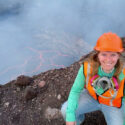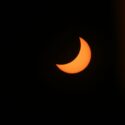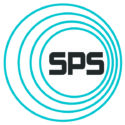Physics major Mary McMullan (Class of ’22) is the recipient of this year’s NSF Fellowship Award, and Professor of Physics Dr. Tuan Nguyen has received an NIH (National Institute of Health) award.


Physics major Mary McMullan (Class of ’22) is the recipient of this year’s NSF Fellowship Award, and Professor of Physics Dr. Tuan Nguyen has received an NIH (National Institute of Health) award.

The College of New Jersey’s Physics department was recently recognized by the Physics Teacher Education Coalition (PhysTEC) for its outstanding contributions to the education of future physics teachers. The College of New Jersey graduated 6 well-prepared physics teachers in the 2020-2021 academic year. To recognize this achievement, The College of New Jersey has earned membership in the 5+ Club, the highest award available for teacher preparation from the PhysTEC, a joint project of the American Physical Society (APS) and the American Association of Physics Teachers (AAPT). More information on this award can be found at https://phystec.org/awards/five-plus-club.

In the very early morning of Friday November 19th, the full Moon slipped into the Earth’s shadow in an almost complete lunar eclipse, the longest in the century. This eclipse is particularly long because the Moon is at its farthest distance from the Earth on its elliptical orbit. During an eclipse, the Moon loses access to most of the sunlight that it usually reflects and can only reflect the small portion of redder light that bend around the Earth and through its atmosphere on the way to the Moon.
The four pictures below were taken by three physics majors. Connor McNeill (Class of 2024) and Michael Pedowitz (Class of 2024) took pictures that placed the lunar eclipse in the broader stellar context. In Connor’s picture, you can see Orion’s belt and sword to the left of the still relatively bright Moon (Fig. 1). Michael’s shows that the Moon was located right next to the Pleiades cluster, a set of seven bright stars that are sometimes called the Seven Sisters (Fig. 2).
Connor and Dean Klunk (Class of 2024) also took images of the Moon through a telescope. Connor used his own 3in telescope (Fig. 3), while Dean operated the physics department’s 11in telescope from the rooftop observatory (Fig. 4). The observatory is open to the students as well as the public on clear nights Mondays to Thursdays from 8pm to 10pm.
Fig. 1: The Moon (bright object on the right) was located close Orion, whose belt and sword can easily be seen at the left on the image. Picture Credit: Connor McNeill
Fig. 2: To the upper right of the Moon, the cluster of stars is the Pleiades, sometimes called the Seven Sisters. Picture Credit: Michael Pedowitz
Fig. 3: The Moon taken through a 3in telescope during the maximum of the partial eclipse. The white edge to the upper right shows that the eclipse was not complete. The red color is the result of sunlight passing through the Earth’s atmosphere before reaching the Moon. Picture Credit: Connor McNeill
Fig. 4: The Moon as seen through TCNJ’s 11in telescope. This larger telescope shows more detail with the mare (dark regions) becoming especially visible, as well as Tycho’s crater (lower right).

TCNJ Physics department professor Dr. Shannon Graham has recently published an article for the American Geophysical Union titled “A Global Set of Subduction Zone Earthquake Scenarios and Recurrence Intervals Inferred From Geodetically Constrained Block Models of Interseismic Coupling Distributions”. You can read the article in full by clicking on this link to the AGU official website. A brief summary of the research conducted for this article can be found below:
“In this study, we use results from a global tectonic and earthquake cycle model based on GPS measurements to estimate the locations and magnitudes of potential earthquakes on 16 of the world’s largest faults. Along these faults, two tectonic plates are coupled, or stuck together, to varying degrees causing the nearby portions of the plates to undergo distortion, which can be tracked using GPS. Studies of recent earthquakes suggest that slip occurred on the region of the fault that was stuck together prior to the earthquake. With this in mind, we use a model of global fault coupling to find regions where additional great earthquakes may occur. We suggest that nearly all of the world’s subduction zones, as well as the fault beneath the Himalayas, could produce a magnitude 9 or greater earthquake.”

Dr. Daniel Capic has officially joined TCNJ’s Department of Physics this fall as the HHMI Fellow and Visiting Professor of Physics.

If you’re in the tri-state area and look to the skies early on Thursday morning, June 10, you might notice something highly unusual — the rising sun will resemble a crescent moon.
Lauranne Lanz, assistant professor of physics, explains what you need to know about this quirky springtime sunrise.
On June 10, we’ll get to see a partial solar eclipse, Lanz says. Solar eclipses happen when the moon passes in front of the sun from our perspective here on Earth. Partial eclipses happen when the moon is in front of only part of the sun at the start or end of the eclipse. In this case, 80 percent of the sun will be blocked by the moon.
Lanz explains that what’s happening on June 10 is actually an annular eclipse, which is a specific kind of solar eclipse. And this one is pretty rare, happening only twice in our area in the past 150 years.
“The moon’s orbit of the Earth is an ellipse — an oval — rather than a perfect circle, so sometimes it’s closer to the Earth and sometimes it’s further away,” she explains. “When it’s further away, it’s a little bit smaller than the sun in terms of how much of the sky each fills up, so at the moment of exact alignment, you can see a ring — an annulus — of the sun around the edges of the moon.”
Kind of. On the east coast, we won’t see the full annular eclipse due to timing and alignment. But, we will be able to see the partial alignment that gives rise to a special sunrise described as a scimitar — a curved sword — as long as it’s not cloudy.
“It will be visible right at the east-northeast horizon at 5:32 a.m. and will gradually shift away from the sun and be gone by 6:30 a.m.,” Lanz says.
So set your alarms bright and early for this once-in-a-lifetime magical morning!
— Emily W. Dodd ’03

The Department of Physics invites applications for a non-tenure track Teacher-Scholar Faculty Fellow at the rank of Visiting Assistant Professor, starting August 2021. The candidate must have a PhD in Physics and should be interested in pursuing an academic career at a primarily undergraduate institution where teaching and research are both valued and integrated. The position is offered for two consecutive years and is funded in part by a grant to TCNJ from the Howard Hughes Medical Institute through the Science Education Program. The selected Teacher-Scholar Fellow will work closely with experienced faculty mentors gaining professional development in inclusive pedagogy, course design, student mentoring, and grant proposal writing. The Fellow will have an opportunity to engage highly motivated undergraduates in research, gain teaching experience, and receive mentoring toward attainment of a full-time, tenure-track faculty position. Apply by May 25.
The advertisement and instructions on how to apply for the position can be found here: https://tcnj.taleo.net/careersection/00_ex_staff/jobdetail.ftl?job=21000464

Dr. Mariah MacDonald will be joining TCNJ’s Department of Physics this fall as the Clare Boothe Luce Assistant Professor of Physics. Dr. MacDonald recently earned a dual-title PhD from Pennsylvania State University in Astronomy & Astrophysics and Astrobiology. She had previously earned bachelor degrees in Physics and Astronomy & Astrophysics from Florida Institute of Technology. Her research focuses on the dynamics of exoplanets, that is the orbits of planets located in solar systems around other stars. She investigates how these systems form and how the locations of planets within them evolve over time, using computational simulations and calculations. In the fall, she will be teaching Physics 163 Astronomy: Stars and the Universe. The Clare Boothe Luce Professorship was awarded to the TCNJ Physics Department by the Henry Luce Foundation in order to support women in the sciences and engineering.

TCNJ Physics majors can take advantage of an outstanding new study abroad opportunity, specifically designed for them: The Experiential Learning Berlin-America (ELBA) project. This is a project with our partner institution Beuth University of Applied Science, (https://www.beuth-hochschule.de/) also known as Berlin Institute of Technology (BHT) located in Berlin, Germany.
Over the next 4 years (2021-2024), up to 24 TCNJ physics majors can travel and live in Germany to participate in science/technology experiential learning facilitated by BHT. The travel occurs during May and June and most of the student travel and living expenses are provided by BHT. Students may also earn academic credit for this study abroad experience, and may combine this experience with a full-time paid summer research fellowship at TCNJ following their return from Germany.
The project also includes the development and delivery of Collaborative On-line International (COIL) courses and funds for in-person culminating visits for as many as 36 TCNJ students to German research institutes and cultural institutions. Funds will also support TCNJ faculty and administrative staff training and collaborative engagement with BHT faculty and administrative staff.
TCNJ Physics majors are highly encouraged to start planning their application to these programs early in their second year, in consultation with their faculty advisor. For more information, contact Prof. David J. McGee at mcgeed@tcnj.edu

Student-Led Physical Sciences Organization is Honored with Award from the National Office of the Society of Physics Students as an Outstanding Chapter
The College of New Jersey’s chapter of the Society of Physics Students (SPS) has won an Outstanding Chapter Award from the SPS National Office. The chapter, advised by Professor of Physics Dr. Romulo Ochoa, has been recognized numerous years in a row for its excellence as a top-tier student-led physical sciences organization, a designation given to fewer than 10 percent of all SPS chapters at colleges and universities in the United States and internationally.
The Society of Physics Students (SPS) is a professional association designed for students and membership is open to anyone interested in physics and related fields. SPS operates within the American Institute of Physics (AIP), an umbrella organization for professional physical science societies.
SPS chapters are evaluated on their level of interaction with the campus community, the professional physics community, the public, and with SPS national programs. The Outstanding Chapter Award recognizes high levels of outreach as well as unique approaches to fulfilling the mission of SPS to “help students transform themselves into contributing members of the professional community.”
Physics Department
Science Complex, Room P123
The College of New Jersey
P.O. Box 7718
2000 Pennington Rd.
Ewing, NJ 08628